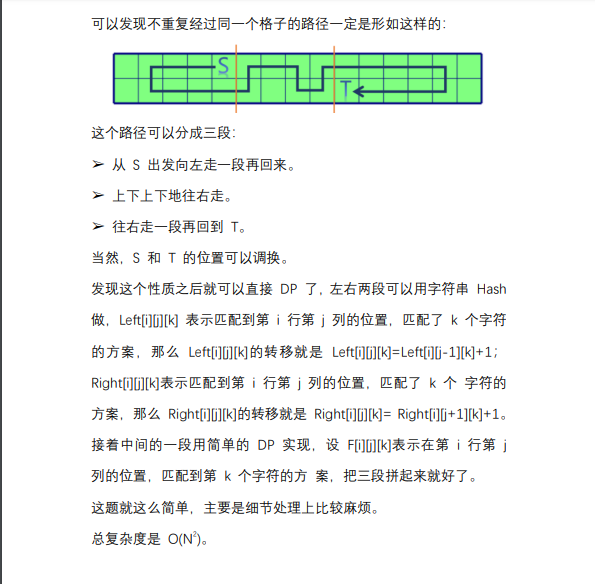Puzzle Lover
Oleg Petrov loves crossword puzzles and every Thursday he buys his favorite magazine with crosswords and other word puzzles. In the last magazine Oleg found a curious puzzle, and the magazine promised a valuable prize for it's solution. We give a formal description of the problem below.
The puzzle field consists of two rows, each row contains n cells. Each cell contains exactly one small English letter. You also are given a word w, which consists of ksmall English letters. A solution of the puzzle is a sequence of field cells c1, ..., ck, such that:
- For all i from 1 to k the letter written in the cell ci matches the letter wi;
- All the cells in the sequence are pairwise distinct;
- For all i from 1 to k - 1 cells ci and ci + 1 have a common side.
Oleg Petrov quickly found a solution for the puzzle. Now he wonders, how many distinct solutions are there for this puzzle. Oleg Petrov doesn't like too large numbers, so calculate the answer modulo 109 + 7.
Two solutions ci and c'i are considered distinct if the sequences of cells do not match in at least one position, that is there is such j in range from 1 to k, such that cj ≠ c'j.
Input
The first two lines contain the state of the field for the puzzle. Each of these non-empty lines contains exactly n small English letters.
The next line is left empty.
The next line is non-empty and contains word w, consisting of small English letters.
The length of each line doesn't exceed 2 000.
Output
Print a single integer — the number of distinct solutions for the puzzle modulo 109 + 7.
Examples
code
edoc
code
4
aaa
aaa
aa
14
sol:超好的一道dp题

事实上我代码和上面略有不同
提醒一下:注意一点就是不要算重,比如要向左或向右绕一圈回来的时候一圈的长度最小值为4,因为直接往下走的话在中间那段的转移中已经算过了

#include <bits/stdc++.h> using namespace std; typedef long long ll; inline ll read() { ll s=0; bool f=0; char ch=' '; while(!isdigit(ch)) { f|=(ch=='-'); ch=getchar(); } while(isdigit(ch)) { s=(s<<3)+(s<<1)+(ch^48); ch=getchar(); } return (f)?(-s):(s); } #define R(x) x=read() inline void write(ll x) { if(x<0) { putchar('-'); x=-x; } if(x<10) { putchar(x+'0'); return; } write(x/10); putchar((x%10)+'0'); return; } #define W(x) write(x),putchar(' ') #define Wl(x) write(x),putchar(' ') const int N=2005; const ll Base=97,Mod=1000000007; int n,Len; char S[2][N],T[N]; inline void Ad(ll &x,ll y) { x+=y; x-=(x>=Mod)?Mod:0; } ll Seed[N]; inline void Prepare(int n) { int i; Seed[0]=1; for(i=1;i<=n;i++) Seed[i]=1ll*Seed[i-1]*Base%Mod; } struct Hash { ll Hash[N]; inline void Make(int n,char *S) { int i; Hash[0]=0; for(i=1;i<=n;i++) Hash[i]=(Hash[i-1]*Base%Mod+(S[i]-'a'+1))%Mod; } inline ll Ask(int l,int r) { return (ll)(Hash[r]+Mod-Hash[l-1]*Seed[r-l+1]%Mod)%Mod; } }Pre[2],Suf[2],HT; ll dp[2][N][N]; //dp[i][j][k]表示在第i行,第j-1个(即i,j在当前点右边),已经匹配了k为的方案数 inline ll Solve(bool opt) { ll res=0; int i,j,k; memset(dp,0,sizeof dp); for(j=1;j<=n;j++) { dp[0][j][0]=dp[1][j][0]=1; for(i=0;i<=1;i++) for(k=2;k<=min(n-j+1,Len/2);k++) //向右绕一圈回来 { if(Pre[i].Ask(j,j+k-1)==HT.Ask(Len-2*k+1,Len-k)&&Suf[i^1].Ask(n-(j+k-1)+1,n-j+1)==HT.Ask(Len-k+1,Len)) { if((k*2!=Len)||opt) Ad(res,dp[i][j][Len-k*2]); } } for(i=0;i<=1;i++) for(k=2;k<=min(j,Len/2);k++) //向左绕一圈回来 { if(Suf[i].Ask(n-j+1,n-(j-k+1)+1)==HT.Ask(1,k)&&Pre[i^1].Ask(j-k+1,j)==HT.Ask(k+1,k*2)) { if((k*2!=Len)||opt) Ad(dp[i^1][j+1][k*2],1); } } for(i=0;i<=1;i++) for(k=1;k<=Len;k++) { if(T[k]==S[i][j]) { Ad(dp[i][j+1][k],dp[i][j][k-1]); if(k<Len&&T[k+1]==S[i^1][j]) { Ad(dp[i^1][j+1][k+1],dp[i][j][k-1]); } } } for(i=0;i<=1;i++) Ad(res,dp[i][j+1][Len]); } return res; } int main() { ll i,j,ans=0; Prepare(2000); scanf("%s",S[0]+1); n=strlen(S[0]+1); scanf("%s",S[1]+1); scanf("%s",T+1); Len=strlen(T+1); for(i=0;i<=1;i++) { Pre[i].Make(n,S[i]); reverse(S[i]+1,S[i]+n+1); Suf[i].Make(n,S[i]); reverse(S[i]+1,S[i]+n+1); } HT.Make(Len,T); Ad(ans,Solve(1)); if(Len>1) { reverse(T+1,T+Len+1); HT.Make(Len,T); Ad(ans,Solve(0)); } if(Len==2) { for(j=1;j<=n;j++) for(i=0;i<=1;i++) if(S[i][j]==T[1]&&S[i^1][j]==T[2]) Ad(ans,Mod-1); } Wl(ans); return 0; } /* input code edoc code output 4 input aaa aaa aa output 14 input v s sv output 1 */
